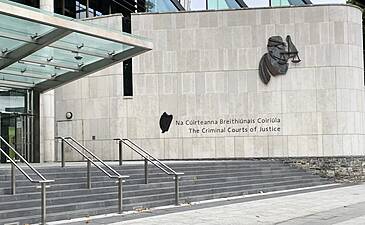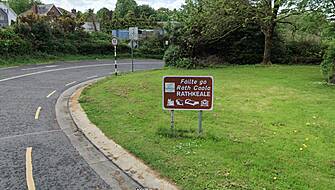There is a “cornucopia of evidence” linking ‘tiger kidnapper’ and gangland criminal Paschal Kelly to a post office robbery in which three women were tied up and abducted, the Court of Appeal has been told.
However, lawyers for Kelly in his appeal against his conviction and 18-year sentence have questioned the quality of CCTV footage involved in the case and said the jury in the original trial should have been warned against making any identification.
Quality of CCTV
At the Court of Appeal on Monday, defence counsel Martin O’Rourke KC said that the jury should have been warned against making their own identification of Kelly as the CCTV footage is not of sufficient quality.
However, counsel for the prosecution Eoin Lawlor BL said that DNA evidence also identifies Kelly’s part in the robbery of €92,000 from a Dublin post office in 2014.
Kelly (56) was one of a gang of three men who burst into the home of a postmistress in Malahide on September 25th, 2014.
The gang used cable ties to bind the postmistress, her daughter and an Italian student who was staying at the home. The women were brought to a field where they were held overnight before the gang drove them to the Bayside Post Office in Sutton, Dublin.
At one stage Kelly threatened to burn them alive in a car by pouring petrol over it. The raiders eventually left with the cash.
Kelly, with last addresses in Cootehill, Co Cavan, and Castlepollard, Co Westmeath, was convicted of trespass and the false imprisonment of the three women.
He was also convicted of robbery, of threatening to kill the three women and of possession of a stolen vehicle, all on the same date.
The father-of-two had denied all charges but was found guilty by the jury and sentenced to 18 years by Dublin Circuit Criminal Court in 2018.
He subsequently launched an appeal against this conviction.
DNA evidence
Outlining the replying submissions for the State, Mr Lawlor said that the appellant was the driver of a Volkswagen Golf used in the robbery. A garda detective described the driver of the Golf as being in his 40s and of stocky build, while another detective described him as being approximately 50 with an unkempt grey beard.
Mr Lawlor said the driver of the Golf hit a car before he fled the scene on foot. He was captured on CCTV and both detectives later viewed the CCTV and identified the driver as being the person who ran away. The driver discarded items of clothing such as a neck warmer and a woollen hat, and Mr Lawlor said that DNA matching Kelly’s was found on these items. Fibres from the neck warmer and hat were found in the Golf.
Mr Lawlor said that a taxi driver gave evidence of Kelly “jumping out of the shadows” to hail his taxi. The taxi driver took Kelly up the M1 and stopped at a service station, where CCTV showed the appellant buying cigarettes. The taxi driver then dropped him to an estate in Balbriggan where the appellant’s partner lived.
Mr Lawlor said that a bottle of water was found in the Volkswagen Golf from which a sample of DNA matching the appellant’s was taken.
Mr Lawlor said that the two detectives independently identified the driver of the Golf.
“It is a case of circumstantial evidence and identification is a plank of it,” said Mr Lawlor.
He said that in addition to DNA, there were descriptions that matched the appellant and CCTV footage. He said the jury in the trial knew the features and build of the person they were shown in the CCTV footage and they were cautioned against the dangers of relying on identification.
“The DNA evidence exists within a cornucopia of evidence, all of which points towards the appellant,” said Mr Lawlor.
Identification
Mr Justice Patrick McCarthy asked counsel for the State was it his submission that, even if the identification by the gardaí was potentially unreliable, then the jury should still have received it as there was other evidence to support it.
Mr Lawlor replied this was the case and said the identification was compounded by other evidence. He said Kelly fled the car, discarded items of clothing, and got a taxi.
“The detectives did not say the person in the footage was the appellant, they said it was the person they saw as the driver,” said Mr Lawlor.
“The court is aware of the dangers of identification evidence, but the other evidence is such that the court can be satisfied the identification was correct.”
Outlining the submission for the defence, Mr O’Rourke said the DNA sample from the clothing showed a mixed DNA profile and did not indicate who the wearer was at the time of the offence.
“If the jury was considering the DNA alone it would be difficult for them to say it was him. By the chain of events, it is said he is the driver,” he said.
Mr O’Rourke said that the trial judge was wrong to conclude that the quality of the CCTV footage was sufficient to leave it to the jury.
“It should not have been left to the jury to identify him due to the quality,” said Mr O’Rourke.
He said there was no quality control in this case.
Circumstances
“The circumstances were fraught with difficulty. All of the factors that would make identification difficult were present. It was done in extremely difficult circumstances. The judge should have told the jury not to attempt to make any identification themselves,” said Mr O’Rourke.
He said that when the quality of CCTV falls below a certain level, a warning should be given not to attempt to identify.
“I have no difficulty with it being admitted as a piece of real evidence. But you can’t look at it and look at Mr Kelly and connect the two,” he said.
“A warning should be given that the jury does not attempt to make identification,” he said.

Mr Justice McCarthy said that if the gardaí identified someone, to make sense of the case the jury would have to be shown the footage.
“How can you exclude the footage? How can you say the gardaí can’t make a judgement call as to the identification?” he asked.
“The judge should have told the jury not to make any identification due to the quality of the footage,” said Mr O’Rourke.
Mr Justice John Edwards said there was a lot of material in this case and the court needed time to reflect on it. He said the court would reserve judgement in the matter.







